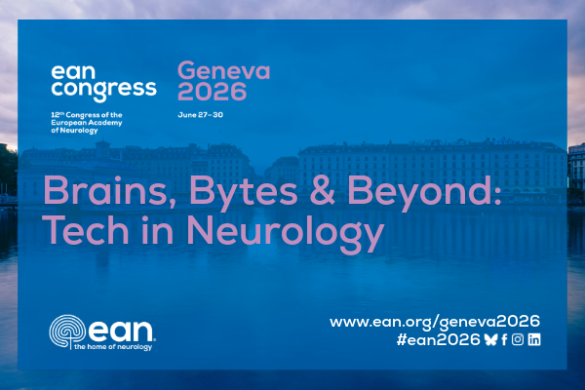by Elena Moro
For July 2018, we have selected: Thomalla G, Simonsen CZ, Boutitie G, et al., for the WAKE-UP Investigators. MRI-guided thrombolysis for stroke with unknown time of onset. NEJM May 16, 2018. doi:10.1056/NEJMoa1804355.
Thrombolysis is currently performed in patients with acute ischemic stroke within a window of 4.5 hours since the symptoms’ onset. In about one third of the patients, the exact time of stroke onset is unknown, like in patients who wake up from sleeping. In such patients, intravenous thrombolysis is not currently recommended. To improve access to iv thrombolysis, the mismatch between some brain MRI sequences has been used. The absence of hyperintense signal in FLAIR sequences together with the evidence of diffusion-weighted imaging lesions in the same brain region suggest that the stroke may have occurred within the last few hours. Alternatively, it may suggest that some brain parenchyma can still be saved (the penumbra area).
In this multicenter, investigator-initiated, randomized, double-blind, placebo controlled trial, the authors assessed the outcomes of thrombolysis intervention in stroke patients with unknown time of stroke onset. The trial was supported by the European Union Seventh Framework Program. Patients otherwise eligible for thrombolysis (with alteplase, 0.9 mg/kg IV) were screened according to the presence of brain MRI mismatch. Patients with intracranial hemorrhage or ischemic lesions involving more than one third of the middle cerebral artery territory, or NIHSS >25, were not included. Primary outcome was defined as a score of 0 or 1 on the modified Rankin scale at 90-day time point after randomization. Secondary outcomes included the infarct volume on MRI between 22 and 36 hours, and ordinal scores on the modified Rankin scale, a global outcome score, the Beck Depression Inventory score, and two EuroQol-5 dimension scales scores at 90 days. Primary and secondary safety end points were also established, being death and a composite outcome of death or dependence, and the incidence of intracranial bleeding, respectively.
An intention-to-treat approach was used. Unconditional logistic-regression model was used for analyzing the primary outcome. About 800 patients were estimated to be needed to have 80% power to show the expected treatment effect.
Patients were enrolled between September 2012 and June 2017 at 61 centers in eight European countries. The study was stopped in June 2017 due to lack of funding. Of the 503 patients included, 254 were randomized towards alteplase and 249 towards placebo. Clinical characteristics were similar between the two groups. The median NIHSS score at baseline was 6, whereas the median time between symptoms’ recognition and treatment was 3.1-3.2 hours.
There was a significant more favorable outcome in 55.3% (131/246) of the patients with alteplace compared to 41.8% (102/244) of those with placebo at 3months (adjusted OR 1.61, 95% CI, 1.09-2.36, p=0.02). Median score of the modified Rankin scale was 1 in the alteplase group and 2 in the placebo group (common OR 1.63, 95% CI, 1.17-2.23, p=0.003). Quality of life measures overall favored the alteplase group compared to placebo. There was no significant difference between group concerning death or inability to live independently at 90 days (adjusted OR 0.68, 95% CI, 0.92-12.52, p=17). Parenchymal hemorrhage was more frequent in the alteplase group (adjusted OR 10.46, 95% CI, 1.32-82.77, p=0.03).
“This study supports the use of thrombolysis in patients with unknown stroke onset. It also stresses the importance of the mismatch MRI criteria to select patients to the treatment.”, says Prof. Charlotte Cordonnier, Division of Neurology, University of Lille, France. “Two recent clinical trials have also supported the use of thrombectomy in patients with uncertain stroke time onset. The conventional clock will be less important in the near future of stroke therapies. MRI data and other biomarkers will contribute to define the concept of tissular clock that will guide our reperfusion strategies.”
“It is unfortunate that the study could not enroll the goal number of patients. This would have allowed further analysis,” says Prof. Catarina Fonseca, Department of Neurosciences, University of Lisbon, Portugal. “There were more intracranial hemorrhages in the alteplase groups and numerically more deaths. These findings are in keeping with previous published trials but they could have been better analyzed with a larger sample size.”
The other nominees for the July 2018 Paper of the month are:
- Wilson D, Ambler G, Shakeshft C, et al., on behalf of the CROMIS-2 collaborators. Cerebral microbleeds and intracranial haemorrhage risk in patients anticoagulated for atrial fibrillation after stroke or transient ischaemic attack (CROMIS-2): a multicenter observational study. Lancet Neurol 2018; 17:539-547. This multicenter observational study involved 1,490 patients with atrial fibrillation and recent ischemic stroke or transient ischemic attack treated with oral anticoagulants and followed prospectively up to 2 years. The presence of cerebral microbleeds was found to be independently associated with a significant higher risk to have intracerebral bleedings.
- Johston AC, Easton JD, Farrant M, et al., for the Clinical Research Collaboration, Neurological Emergencies Treatment Trials Network, and the POINT Investigators. Clopidogrel and aspirin in acute ischemic stroke and high-risk TIA. NEJM 2018 May 16. doi: 10.1056/NEJMoa1800410. The risk of a recurrent stroke at 3 months was assessed in 4,881 patients who were randomized to receive either clopidogrek plus aspirin or the same range of aspirin alone after a minor ischemic stroke or TIA. The combination of clopidogrel and aspirin was associated with lower risk of stroke and higher risk of bleeding compared to aspirin alone.
- Sprigg N, Flaherty K, Appleton JP, et al., for the TICH-2 Investigators. Tranexamic acid for hyperacute primary intracerebral haemorrhage (TICH-2): an international randomized, placebo-controlled, phase 3 superiority trial. Lancet Neurol 2018 May 16. 10.1016/S0140-6736(18)31033-X. Around 2,325 patients with intracranial hemorrhage were randomized to receive 1 g intravenous tranexamic acid bolus followed by an 8 h infusion of 1 g tranexamic acid or a matching placebo, within 8 h of symptom onset. At 3-month follow-up there was no significant difference in the functional status between the tranexamic acid group and the placebo group.
- Hart RG, Sharma M, Mundl H, et al., for the NAVIGATE ESUS Investigators. Rivaroxaban for stroke prevention after embolic stroke of undetermined source. N Eng J Med May 16, 2018; doi:10.1056/NEJMoa1802686. In this multicenter trial, efficacy and safety of 15 mg rivaroxaban, an oral factor Xa inhibitor, was compared with 100 mg aspirin in preventing recurrent stroke in 7,213 patients with recent ischemic stroke presumed from cerebral embolism. No differences were found between the two medication in stroke prevention, but rivaroxaban was associated with higher risk of bleeding.












